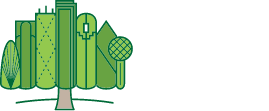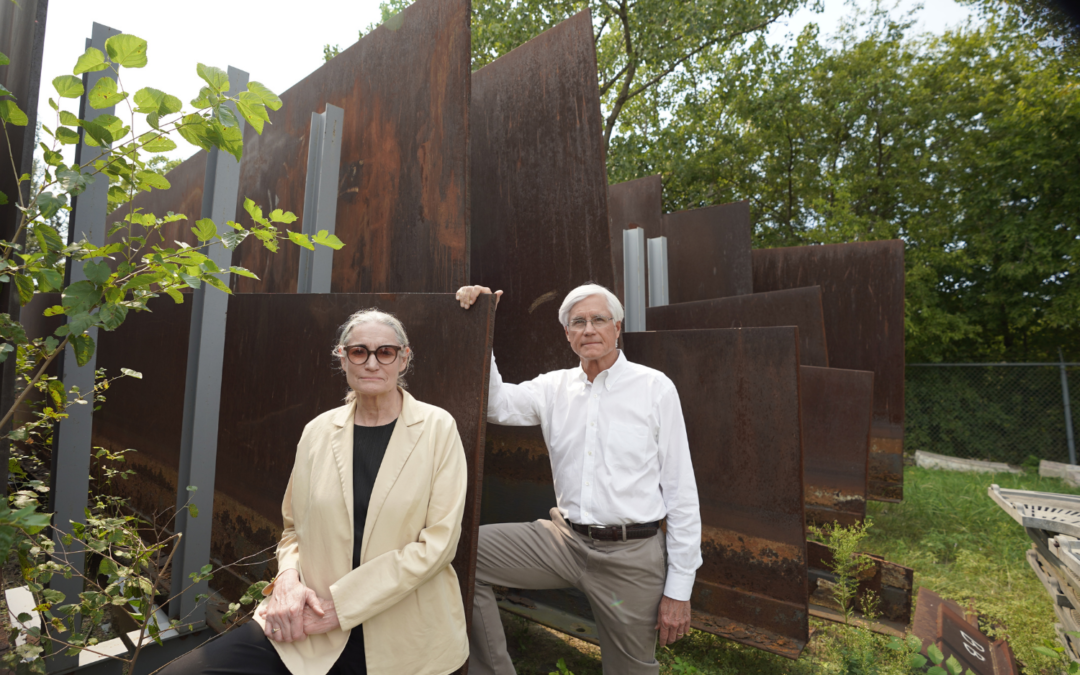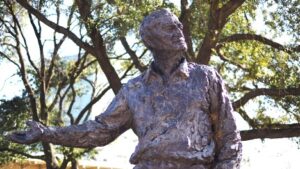Photo: Laura Carpenter and her brother John Carpenter III with “Portal Park Slice” at I.C. Harris Service Center in Dallas, Texas.
Carpenter Park will one day be the largest public park in Downtown Dallas, providing a crucial connection between the city’s urban center, Deep Ellum and East Dallas. The new park will include a notable expansion and new amenities, including a piece of world-class art, created by famed post-war artist Robert Irwin.
Originally known as Portal Park Piece (Slice), this sculpture has long been considered Irwin’s seminal work in a career of minimalist, site-specific installations that span more than five decades. The sculpture consisted of steel panels that cut through four landscape mounds, emphasizing the interaction between hard and soft, cityscape and landscape. The piece, which was jointly funded by the City of Dallas, the National Endowment for the Arts and the Southland Financial Corporation, was installed in Carpenter Plaza in 1981 and marked the “eastern gateway to the city’s central business district.”
But due to road reconfigurations, this vehicular gateway into the city was closed and the sculpture no longer served as a portal within the landscape. Even Irwin himself, now 92 years old, granted the city permission to remove the sculpture because of the evolving site conditions. Fortunately, after working closely with Mary Margaret Jones and George Hargreaves of Hargreaves Jones, the landscape architecture firm behind Carpenter Park’s design, Irwin agreed to reimagine the piece, marking a return to this work over 30 years later.
In 2016, the sculpture was carefully removed from Carpenter Plaza, cut into 20-foot sections and disassembled. In the redesign, Irwin reused almost all of the original piece, while also adding two additional sections of Cor-Ten, the weathering steel that makes up the original sculpture. These new sections will include intricate filigree detailing designed by Irwin and carved into the steel with the use of a water jet cutter.
Once installed into the new space, the sculpture will be reoriented on an east-west axis, unlike the north-south axis of the original, and will run on the north side of the park through a large grass-covered mound. Irwin has renamed his reconfigured sculpture Portal Park Slice.
As its name suggests, the original sculpture was to serve as a “portal” to Downtown Dallas, and the new sculpture aims to accomplish the same for a new generation of Dallasites. Irwin, who in 1984 became the first artist to win the MacArthur Foundation “genius” award, has seen a late boom in his career, and some have pointed to the significance of him revisiting this installation from early in his career.
The new Portal Park Slice will be a fixture of Carpenter Park when it opens in spring of 2022. We recently spoke with Laura Carpenter about the commissioning of the original sculpture in the 1970s and its future in Carpenter Park. This interview has been lightly edited for clarity.

In conjunction with your prominent role at Delahunty Gallery, you spearheaded the commission and funding of Robert Irwin’s sculpture at Carpenter Plaza. Tell us about that time and the process of bringing this important piece to Dallas.
The National Endowment for the Arts (NEA) chose Robert Irwin as the artist for the park. It was his first major public commission. [T]he cost of the sculpture was split between the NEA and [the Carpenter] family, and the land was donated by my family – led by my uncle, Dan Williams, and my father, Ben Carpenter. Because of my rather passionate interest in contemporary art my father asked me to “shepherd” Bob while he was working on this. It was my great honor to do so.
My father and uncle might have chosen a more traditional artist for the commission – this was the 1970s – but my father grew to like and admire Bob. He liked his solution to the particular problem of the park site spanning three disparate blocks. My father had explained to Bob that many of the views of the park would be from above; Bob’s solution was to unite the park with the iron slice through an undulating landscape, adding a visually unified and unfussy green space for viewers where there was none.
Interestingly, one of the future works of art that Bob described wanting to do and was a favorite of mine, ended up in Dallas in the collection of Howard Rachofsky. So, Dallas has two major Irwin works. Also, Bob was not so famous in the 1970s, and he was still partly supporting himself by teaching ballroom dancing and betting on horses.
Tell us about your philosophy with respect to public art, specifically its role in important public spaces like Carpenter Park.
Art has become more integrated in public parks, rather than just some piece of stone or metal plopped down in a park. The Irwin sculpture is one of the first pieces (even though the configuration has changed) to have done that.
Now that Carpenter Park is officially underway, and the other Downtown Priority Parks are being built, what do you think this means for the center city?
Robert Decherd’s efforts mean that Downtown Dallas will be a vibrant center for the city, rather than an isolated relic to another time. Dallas is lucky to have him!
What does Carpenter Plaza, and the forthcoming Carpenter Park, mean to you and your family?
A great deal. My grandfather, father, and uncle were visionaries and participants in making Dallas a great city. I am very proud to have known them and glad there is a memorial to their contributions.
The highly anticipated Carpenter Park marks the third of four Downtown parks that will transform Dallas’ urban core. Downtown Dallas Parks Conservancy is making the city a more vibrant and walkable place through the development of four dynamic neighborhood parks. But the success of this effort hinges on community support. Learn more and Support the Parks with a tax-deductible donation.





